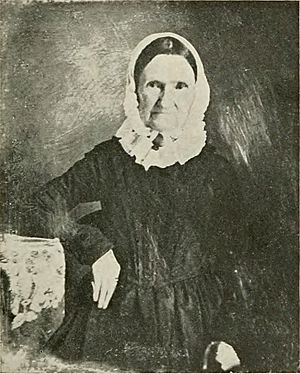Jeremiah Evarts facts for kids
Quick facts for kids
Jeremiah F. Evarts
|
|
|---|---|

Jeremiah Evarts, around 1817
Painting by Samuel Morse |
|
| Born | February 3, 1781 Sunderland, Vermont, U.S.
|
| Died | May 10, 1831 (aged 50) Charleston, South Carolina, U.S.
|
| Known for | 19th-century missionary work, opponent of Indian Removal Act |
| Parent(s) |
|
Jeremiah F. Evarts (born February 3, 1781 – died May 10, 1831) was an important Christian missionary and activist. He worked hard to protect the rights of Native Americans in the United States. He was a strong voice against the U.S. government's policy of Indian removal, which forced Native American tribes from their lands. He also wrote under the pen name William Penn.
Contents
Early Life and Family
Jeremiah Evarts was born in Sunderland, Vermont. His father was James Evarts. Jeremiah went to Yale College and graduated in 1802. While at Yale, he was part of a group called Brothers in Unity, where people debated and discussed literature. He became a lawyer in 1806.
Evarts married Mehitabel Sherman Barnes. Her father, Roger Sherman, was one of the people who signed the United States Declaration of Independence. Jeremiah and Mehitabel had a son named William M. Evarts. William later became a very important person in the U.S. government. He served as the United States Secretary of State, the U.S. Attorney General, and a U.S. Senator for New York.
Fighting for Native American Rights
Jeremiah Evarts was deeply affected by a religious movement called the Second Great Awakening. He worked for the American Board of Commissioners for Foreign Missions (ABCFM). This group sent missionaries to other countries. Evarts was their treasurer from 1812 to 1820, and then their Secretary from 1821 until he died in 1831.
Evarts also edited a religious magazine called The Panoplist. He wrote more than 200 essays for it. He wrote twenty-four important essays about the rights of Native Americans. For these essays, he used the pen name "William Penn."
He was a leading opponent of the policy of Indian removal. This policy aimed to move Native American tribes, especially the Cherokee people, from their homes in the Southeast. Evarts tried to convince the U.S. Congress and President John Quincy Adams to keep funding programs that helped Native Americans adapt to white society.
He was a key leader in the fight against President Andrew Jackson's Indian Removal Act of 1830. Sadly, this fight was not successful. The law led to the forced removal of the Cherokees in 1838. This terrible event is known as the Trail of Tears.
Evarts hoped to stop the Indian Removal Act. He tried to get members of Congress who were friendly to his cause to convince others that removing Native Americans was wrong. He also worked to get the public to speak out against the removal policy.
In 1830, the state of Georgia passed a law. It said that white people could not live on Native American land after March 31, 1831, unless they had a license from the state. This law was meant to remove the white missionaries that Evarts had organized through the ABCFM. These missionaries were trying to help Native Americans resist removal by encouraging them to convert to Christianity and get an education. After the Indian Removal Act passed, Jeremiah Evarts encouraged the Cherokees to take their case to the Supreme Court of the United States. They did this in a famous case called Cherokee Nation v. Georgia.
Death and Lasting Impact
Jeremiah Evarts died on May 10, 1831, in Charleston, South Carolina. He had worked so hard fighting against the Indian Removal Act that he became very sick with tuberculosis. He was buried in the Grove Street Cemetery in New Haven, Connecticut.
Historians say that the Christian movement against the removal of Native Americans largely ended when Evarts died. However, his work had a lasting impact. His son, William M. Evarts, later became United States Secretary of State during the presidency of Rutherford B. Hayes. Historians still discuss how Jeremiah's activism might have influenced U.S. foreign policy through his son. The strong moral and religious arguments that Evarts used against the Indian Removal Act also inspired the later abolitionism movement, which fought to end slavery.
Images for kids



